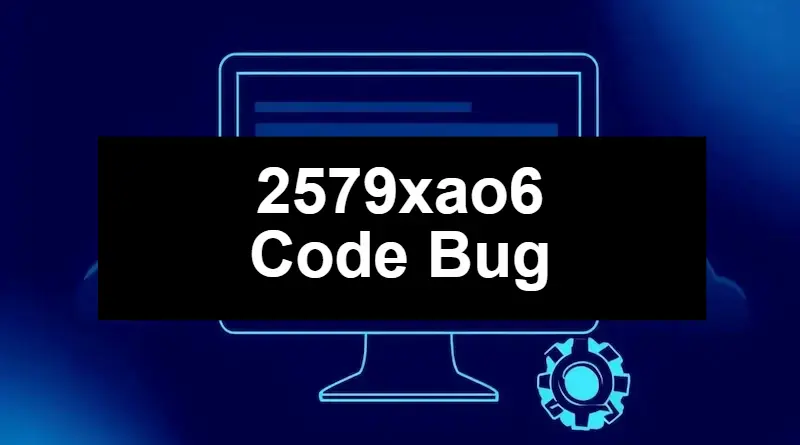Understanding the 2579xao6 Code Bug: Causes, Symptoms, and Solutions?

In the world of software development and IT operations, errors and bugs are inevitable. Among the many cryptic identifiers that developers encounter, the 2579xao6 code bug has recently attracted attention. While not an officially documented error in mainstream frameworks, it is a unique error identifier that surfaces in system logs, runtime exceptions, or debugging reports. For many developers, the challenge lies in not only identifying why the 2579xao6 bug occurs but also in finding reliable fixes that prevent recurring crashes, performance issues, or data loss.
In this article, we will break down everything you need to know about the 2579xao6 code bug—from its causes and symptoms to troubleshooting strategies and long-term prevention. This guide is written for software developers, system administrators, and IT professionals who want a comprehensive understanding of this error and how to resolve it effectively.
What is the 2579xao6 Code Bug?
The 2579xao6 code bug is not a standard error code you would find in popular programming languages like Java, Python, or C++. Instead, it is considered an internal error marker—a placeholder used by some custom-built systems, libraries, or applications to indicate an unidentified failure.
In most cases, the bug acts as a catch-all error identifier, meaning that when the system fails but cannot provide a detailed explanation, it logs “2579xao6” as a way to flag the issue. Developers encountering this bug often struggle because it does not come with descriptive error messages, making diagnosis more complex.
Common Causes of the 2579xao6 Code Bug
Although the error identifier itself is vague, through reported cases and developer community discussions, the 2579xao6 bug is typically linked to several underlying issues:
1. Memory Mismanagement
- Memory leaks, dangling pointers, or improper allocation often lead to system instability.
- The error can occur in environments where large datasets are handled, especially in C/C++ applications.
2. Concurrency and Threading Conflicts
- When multiple processes attempt to access shared resources without proper synchronization, race conditions and deadlocks occur.
- The bug often appears in multi-threaded applications where execution order is unpredictable.
3. Dependency Mismatches
- Outdated or incompatible library versions can trigger the 2579xao6 bug.
- Systems relying on dynamic linking or microservices are especially vulnerable.
4. Uninitialized Variables or Invalid Data
- Failing to initialize variables before use often leads to undefined behavior.
- Data type mismatches or passing invalid arguments also contribute to this bug.
5. Configuration and Permission Errors
- Misconfigured files, incorrect environment variables, or insufficient permissions can generate unexpected crashes marked by this bug.
6. Corrupted Files or Installations
- Broken installation files, corrupted updates, or partial deployments are also common culprits.
Symptoms of the 2579xao6 Code Bug
Identifying the 2579xao6 bug usually involves recognizing certain patterns in system behavior. Some common symptoms include:
- Application crashes or freezes without warning.
- Log files showing only the 2579xao6 identifier without detailed error context.
- Slow performance or memory spikes during execution.
- Partial functionality loss, where some features work while others fail.
- Data corruption risks, especially if the bug occurs during I/O operations.
In many cases, the bug first appears in staging or production environments where workloads are heavier, making it harder to reproduce locally.
Impact of the 2579xao6 Code Bug
The impact of this bug depends on the environment in which it occurs. In critical systems, it can cause:
- Business downtime, resulting in lost productivity and revenue.
- Security risks, if the error exposes vulnerabilities during crashes.
- Data integrity issues, including corruption or loss of transactional data.
- User frustration, especially when the bug is frequent and unpredictable.
This makes it essential for organizations to address the bug quickly and systematically.
How to Troubleshoot the 2579xao6 Code Bug
Fixing the 2579xao6 bug requires a methodical approach. Below are practical steps that developers and IT teams can use:
Step 1: Reproduce the Bug in a Controlled Environment
- Isolate the environment where the bug occurs (development, staging, or production).
- Recreate the same conditions—load, inputs, and configurations—that lead to the error.
Step 2: Analyze Logs and Stack Traces
- Search for “2579xao6” in system logs.
- Collect surrounding log entries, stack traces, and timestamps to identify patterns.
- If available, enable debug logging for deeper insights.
Step 3: Identify the Source in Code
- Use code search tools to locate references to “2579xao6.”
- Investigate whether the identifier is generated by a custom handler or third-party library.
Step 4: Use Debugging and Diagnostic Tools
- For memory issues, use tools like Valgrind, AddressSanitizer, or LeakSanitizer.
- For threading issues, use race detection tools or add locks/mutexes.
- For dependencies, ensure all libraries are updated and compatible.
Step 5: Apply Fixes Based on Root Cause
- Refactor memory allocation and cleanup routines.
- Add proper synchronization in concurrent code.
- Update or roll back incompatible libraries.
- Correct environment variables, permissions, and configurations.
Step 6: Implement Fallback Mechanisms
- Add error-handling routines that provide detailed messages instead of vague identifiers.
- Create graceful recovery paths to prevent system crashes.
Step 7: Test Extensively
- Run automated tests, unit tests, and integration tests.
- Stress-test under high workloads to confirm stability.
Best Practices to Prevent the 2579xao6 Bug
Prevention is always better than troubleshooting. Developers can reduce the chances of encountering the 2579xao6 bug by following these best practices:
- Adopt Defensive Programming
- Always initialize variables, validate inputs, and check boundaries.
- Implement Robust Logging
- Avoid cryptic identifiers like “2579xao6” without explanation.
- Provide meaningful error messages with context.
- Use Version Control for Dependencies
- Lock versions in dependency managers (e.g., package-lock.json, requirements.txt).
- Regularly audit and update third-party libraries.
- Run Continuous Testing
- Integrate automated testing pipelines that catch issues early.
- Document Error Codes
- Maintain an internal catalog of error codes and their meanings.
- Train team members on how to handle specific errors.
- Regularly Monitor Systems
- Use monitoring tools (Prometheus, Grafana, ELK stack) to detect anomalies early.
Real-World Example
Imagine a fintech company running a high-traffic payment gateway. During peak transaction times, the 2579xao6 bug appears, causing partial system failure. Logs provide no clear context beyond the identifier.
Upon investigation, engineers discover that a third-party payment API library was outdated and incompatible with the current framework. After upgrading the dependency and adding better error handling, the bug no longer appears.
This example highlights how critical it is to trace the root cause rather than focusing solely on the error code.
Conclusion
The 2579xao6 code bug may appear mysterious and frustrating, but with the right approach, it can be diagnosed and resolved effectively. Most often, the issue stems from memory mismanagement, threading conflicts, dependency mismatches, or configuration errors. By adopting systematic debugging strategies and best practices, developers can minimize downtime, improve system reliability, and prevent this bug from recurring.
In software engineering, bugs like 2579xao6 remind us of the importance of clear error handling, robust system design, and continuous testing. By learning how to troubleshoot such issues thoroughly, teams can build stronger, more resilient systems that stand up to real-world demands.


